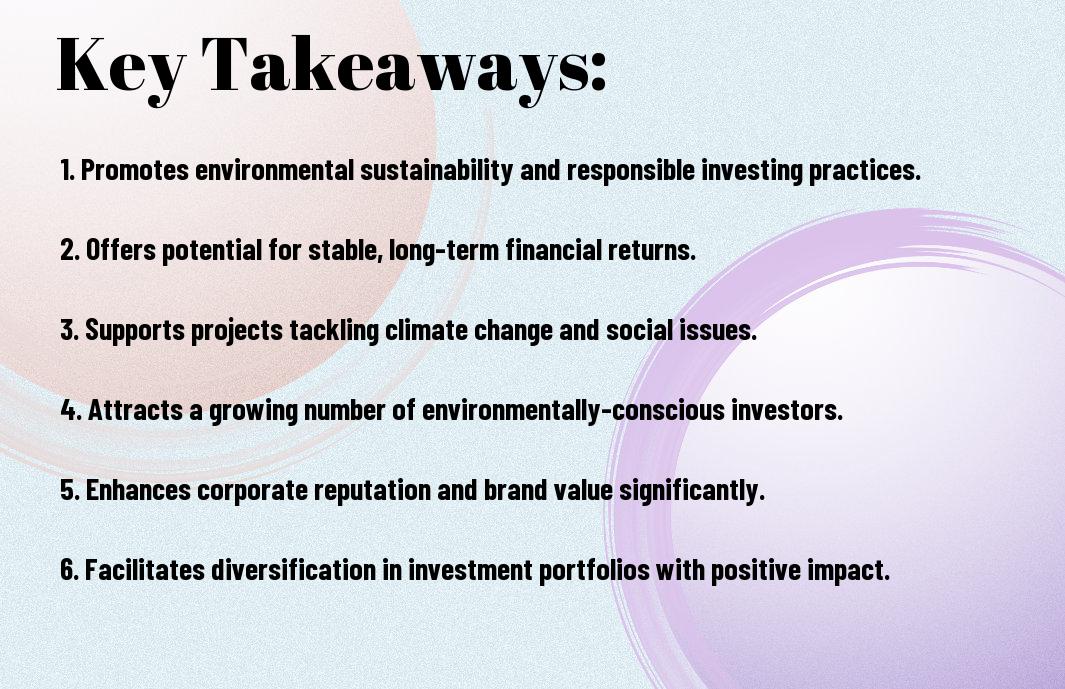There’s a growing interest in sustainable and ethical investing as individuals like you seek to align their financial goals with their values. This approach focuses on investing in companies that prioritize environmental stewardship, social responsibility, and ethical governance. By understanding the foundational principles of this investment strategy, you can make informed decisions that not only enhance your portfolio but also contribute positively to society and the planet. This post will guide you through the crucials of sustainable and ethical investing, helping you navigate this evolving financial landscape.

Key Takeaways:
- Sustainable Investing focuses on generating positive societal impact alongside financial returns, often by investing in companies with eco-friendly practices.
- Ethical Investing aligns investment choices with personal values and societal norms, sometimes involving the exclusion of industries like tobacco or weapons manufacturing.
- ESG Criteria (Environmental, Social, and Governance) are crucial metrics used to evaluate potential investments, assessing how companies manage risks and opportunities related to these factors.

Understanding Sustainable Investing
The world of sustainable investing focuses on generating financial returns while positively impacting society and the environment. You engage in sustainable investing to align your values with your financial goals, supporting companies that prioritize ethical practices, environmental stewardship, and social responsibility. This approach transcends traditional investing by considering broader impacts beyond mere profit.
Definition and Key Concepts
Behind sustainable investing lies a commitment to integrating environmental, social, and governance (ESG) factors into investment decisions. You evaluate not only the potential financial returns but also the ethical dimensions of your investments, opting for companies that foster sustainability and positive societal change.
Historical Context and Evolution
On its journey, sustainable investing has evolved significantly from socially responsible investing (SRI) in the late 20th century. Initially focused on excluding certain industries or practices, it has shifted towards a more comprehensive approach that actively seeks to create positive impact through investment choices.
Another key aspect of this evolution involves the growing recognition of the importance of ESG criteria in assessing risk and potential returns. As global awareness of climate change and social inequality increases, investors like you are more inclined to adopt sustainable practices. This shift has led to the integration of ESG data into mainstream financial analysis, reshaping the investment landscape and fostering a more responsible approach to capital allocation.
Ethical Investing Principles
Even when pursuing financial growth, you can integrate ethical investing principles to align your portfolios with your values. These principles guide you in selecting investments that not only promise returns but also contribute positively to society and the environment. By understanding these principles, you will make informed decisions that resonate with your ethical beliefs and help promote a more sustainable future.
Moral and Social Considerations
On your journey towards ethical investing, it’s necessary to consider the moral and social implications of your investment choices. This means reflecting on how companies influence society, their labor practices, and their environmental impact. By investing in businesses that prioritize social responsibility, you ensure that your capital supports positive change and aligns with your values.
Avoidance of Harmful Industries
For ethical investors, avoiding harmful industries is a key principle. This includes steering clear of sectors such as fossil fuels, tobacco, and arms manufacturing, which often conflict with the values you hold dear. By consciously choosing not to support these industries, you foster a positive impact on both society and the planet.
With an emphasis on avoiding harmful industries, you can shape your investment portfolio to reflect a commitment to sustainability and ethics. By excluding companies that contribute to environmental degradation or social injustice, you actively promote better practices within the market. This approach not only safeguards your investment from potential risks linked to these industries but also drives demand for more responsible alternatives, encouraging positive change in corporate behavior.
The Role of ESG Criteria
After understanding the importance of sustainable and ethical investing, it’s crucial to explore the role of Environmental, Social, and Governance (ESG) criteria. These benchmarks help you evaluate investments based on their impact on society and the planet. Incorporating ESG considerations into your investment strategy can align your portfolio with your values and potentially enhance long-term returns.
Environmental Factors
Before venturing into your investment choices, consider the environmental factors that influence a company’s operations and practices. Analyzing aspects such as carbon emissions, resource management, and waste reduction can provide insight into a company’s commitment to sustainability. You might look for:
- Renewable energy usage
- Water conservation efforts
- Biodiversity initiatives
The focus on these factors allows you to invest in companies committed to minimizing their environmental footprint.
Social and Governance Indicators
Any thorough assessment of ESG criteria should also include social and governance indicators. These factors evaluate a company’s relationships with stakeholders, including employees, customers, and communities, as well as its leadership and policies. Key indicators you may consider are:
- Diversity and inclusion practices
- Labor rights and working conditions
- Board composition and transparency
But social and governance indicators are not just about compliance; they reflect a company’s broader commitment to ethical practices and social responsibility. Your focus on these aspects can enhance the integrity of your portfolio and support companies dedicated to positive societal impact.
Strategies for Sustainable and Ethical Investing
To effectively engage in sustainable and ethical investing, you have several strategies at your disposal. These approaches allow you to align your financial goals with your values while supporting companies that contribute positively to society and the environment. Exploring options like positive screening and impact investing can help you achieve your investment objectives while promoting responsible practices.
Positive Screening
Screening involves evaluating potential investments based on specific criteria that reflect your ethical values. You can filter out companies that do not meet your standards and focus on those actively contributing to sustainable initiatives, such as renewable energy, social justice, and diversity. This approach allows you to support industries that align with your vision for a better world.
Impact Investing
Investing in opportunities that generate measurable social and environmental benefits alongside financial returns is crucial. This approach focuses on companies, organizations, or funds that target specific social issues, such as education, healthcare, or climate change. You can actively contribute to solutions while potentially earning a return on your investment.
Hence, by participating in impact investing, you not only seek a financial return but also prioritize making a positive difference in the world. This strategy encourages you to put your capital to work in ways that create lasting change, fostering innovation and supporting projects with significant societal benefits. It’s an empowering way to invest with purpose, combining your values with financial growth.
Assessing Sustainable Investment Opportunities
Unlike traditional investments that prioritize financial returns alone, sustainable investment opportunities require you to evaluate environmental, social, and governance factors. This holistic approach helps you identify companies that not only exhibit potential for profitability but also align with your values. By integrating sustainability into your investment decision-making process, you can contribute to positive societal change while potentially enhancing your portfolio’s resilience.
Research and Analysis Methods
One effective way to assess sustainable investments is by utilizing frameworks that evaluate the impact of various factors on a company’s performance. These frameworks may include ESG ratings, which analyze a company’s environmental stewardship, social responsibility, and governance practices. Conducting thorough research and employing quantitative and qualitative analysis allows you to make informed decisions that align with your personal investment goals.
Tools and Resources Available
To enhance your evaluation of sustainable investments, several tools and resources can guide your research. These include financial databases, sustainability reports, and screening tools that filter investments based on specific criteria. These resources can help you gain insights into a company’s sustainability performance and its long-term viability.
It’s imperative to leverage these tools effectively to make informed investment choices. Many organizations provide comprehensive databases and platforms that offer access to ESG ratings, sustainability reports, and industry benchmarks. Investing in these resources can empower you with the knowledge needed to navigate sustainable investing confidently, ensuring your choices reflect both your financial aspirations and your commitment to ethical practices.
Challenges and Criticisms
All types of investing come with their unique challenges, and sustainable and ethical investing is no exception. As you navigate this landscape, you may face obstacles such as a lack of standardized metrics for measuring impact, limited investment options, and the evolving regulatory environment. Additionally, you might encounter skepticism surrounding the real effectiveness of these strategies, which can complicate your decision-making process.
Greenwashing and Misleading Claims
Below the surface of sustainable investing, greenwashing poses a significant challenge. As you explore investment options, you may find companies making misleading claims about their environmental practices. This tactic can create confusion and diminish trust, making it difficult for you to discern which investments genuinely align with your values and contribute positively to the planet.
Performance vs. Values
Beside the issue of greenwashing, another challenge you may face is the perceived trade-off between financial performance and personal values. Many investors worry that prioritizing ethics over returns might lead to underperformance compared to traditional investments.
This concern is common, as you may find yourself weighing potential profits against the impact of your investments. However, evidence suggests that sustainable investing can yield competitive returns in the long run. It’s crucial for you to assess your risk tolerance and financial goals while also considering how your investment choices align with your ethical principles, ensuring that both performance and values can coexist in your portfolio.
Summing up
Drawing together the principles of sustainable and ethical investing helps you make informed decisions that align with your values and financial goals. By considering environmental, social, and governance factors, you can contribute to a positive impact on society while potentially enhancing your investment returns. To deepen your understanding and enhance your investment strategies, explore resources like Ethical and Sustainable Investments: The Complete Guide – IG. You have the power to shape a better future through your investments.
FAQ
Q: What is sustainable investing, and how does it differ from traditional investing?
A: Sustainable investing focuses on generating financial returns while also considering environmental, social, and governance (ESG) factors. Unlike traditional investing, which primarily emphasizes financial performance alone, sustainable investing integrates these ESG criteria into the investment decision-making process. This approach aims to promote positive societal impact and environmental stewardship, aligning financial goals with values-based investing.
Q: What are some common strategies for ethical investing?
A: Ethical investing typically involves several strategies, including negative screening, positive screening, and impact investing. Negative screening excludes companies or industries that do not align with the investor’s values, such as those involved in tobacco or fossil fuels. Positive screening seeks to invest in companies with strong ESG practices, while impact investing focuses on capital allocation to projects or businesses that aim to generate measurable social or environmental benefits alongside financial returns.
Q: How can an investor evaluate whether a fund or company is truly sustainable or ethical?
A: Investors can evaluate the sustainability or ethical stance of a fund or company by reviewing ESG ratings, which assess a company’s performance on various criteria such as environmental impact, labor practices, and board diversity. It is also beneficial to read sustainability reports, third-party research, and assessments, and to verify claims made by the company through independent sources. Additionally, engaging with fund managers or companies directly can provide insights into their commitment to sustainable and ethical practices.


